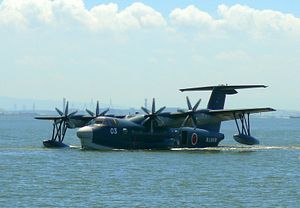The Nikkei Asian Review, citing Japanese officials, reported on Sunday that the groundwork will be finally laid on the Indian side to finalize the sale of 12 ShinMaywa US-2 amphibious aircraft on Monday. The Indian Defense Ministry will approve the purchase of the 12 aircraft at a Defense Acquisitions Council meeting on Monday. Indian Defense Minister Manohar Parrikar will oversee the meeting. Japan had indicated earlier this year that a US-2 sale was not immediately forthcoming given ongoing negotiating difficulties with India, but the deal will now be finalized in the form of a memorandum of understanding during Indian Prime Minister Narendra Modi’s upcoming visit to Japan next week.
The deal has long been in the works between the two countries and would represent Japan’s first major overseas defense contract following the lifting of its self-imposed ban on weapons sales in 2014. India had expressed interest in the platform as early as 2011, when Japan was still governed by the Democratic Party of Japan government. Since the return of the Liberal Democratic Party, led by Abe, in 2012, India-Japan ties have continued to converge. The US-2 sale, along with an anticipated civil nuclear cooperation deal, have been two long anticipated developments in Japan-India ties.
Though the final contours of the deal, including the final price for the 12 units, remains unknown, Nikkei notes that Delhi may negotiate a 8 to 9 percent discount on a purchase valued at $1.6 billion. The US-2 sale, beyond adding momentum to India-Japan ties, will give the Indian Navy an important capability. With a range of 4,500 km and a short take-off ability, the US-2 will stand as a versatile asset for search and rescue missions in the Indian Ocean Region (IOR). The US-2 will enable Indian military missions into the broader IOR and even into Southeast Asian waters.
For Japan, concluding the US-2 deal with India will mark a successful “coming out” event as a normal defense supplier. Abe faced disappointment when Japan’s Kawasaki-Mitsubishi offering of the Soryu-class submarine lost out in Australia’s massive Future Submarine Project competition, with French consortium DCNS’ Shortfin Barracuda-class winning out instead. Though the US-2 is a considerably smaller contract than the $40 billion Australian submarine contract, it will nonetheless be a welcome milestone in Abe’s bid to turn Japan into a major arms exporter.

































